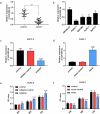MicroRNA MiR-490-5p suppresses pancreatic cancer through regulating epithelial-mesenchymal transition via targeting MAGI2 antisense RNA 3
- PMID: 35043728
- PMCID: PMC8974041
- DOI: 10.1080/21655979.2021.2024653
MicroRNA MiR-490-5p suppresses pancreatic cancer through regulating epithelial-mesenchymal transition via targeting MAGI2 antisense RNA 3
Abstract
Pancreatic cancer with about 5% five-year overall survival rate remains a challenge. Invasion and migration of pancreatic cancer cells are the main factors leading to poor prognosis. MicroRNA-490-5p (miR-490-5p) has anti-cancer effects in a variety of tumors, but its role in pancreatic cancer has not been reported. The mRNA expressions of miR-490-5p, MAGI2 antisense RNA 3 (MAGI2-AS3), Matrix metalloproteinase (MMP)2, MMP9, N-cadherin, and E-cadherin were detected by quantitative real-time PCR, while the protein expressions of these genes except miR-490-5p were measured by Western blot analysis. The cell viability, apoptosis, migration and invasion were detected by cell counting kit-8 (CCK-8), apoptosis and transwell assays. MiR-490-5p was abnormally low-expressed in pancreatic cancer, whose down-regulation generated enhanced effects on viability, migration and invasion in pancreatic cancer cells, as well as MAGI2-AS3 expression. MiR-490-5p mimic exerted the opposite effect on cells, which also down-regulated MMP2, MMP9, and N-cadherin protein expressions, while up-regulating E-cadherin protein expression. MAGI2-AS3, which was the targeted binding site of miR-490-5p, promoted viability, migration and invasion, and inhibited apoptosis of cancer cells. More importantly, miR-490-5p played an anti-cancer role in pancreatic cancer by targeting MAGI2-AS3 and regulating epithelial-mesenchymal transition (EMT), which was partially offset by MAGI2-AS3.
Keywords: Epithelial–mesenchymal transition; MAGI2-AS3; MicroRNA-490-5p.
Conflict of interest statement
No potential conflict of interest was reported by the author(s).
Figures





References
-
- Bailey P, Chang DK, Nones K, et al. Genomic analyses identify molecular subtypes of pancreatic cancer. Nature. 2016;531(7592):47–52. - PubMed
Publication types
MeSH terms
Substances
LinkOut - more resources
Full Text Sources
Medical
Research Materials
Miscellaneous
